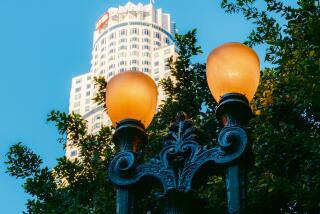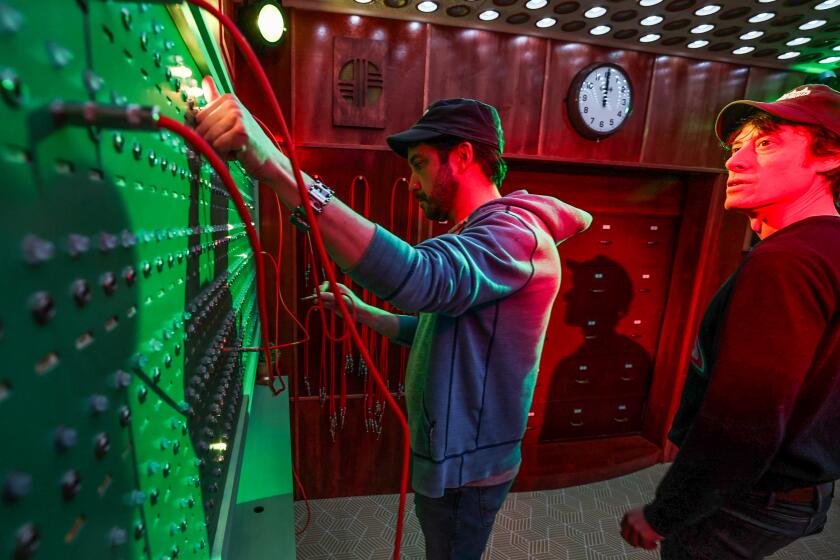In Old Montreal, it all seems to happen on St. Paul Street
St. Paul, the oldest street in one of North America’s oldest cities, runs through the heart of Old Montreal. It’s barely a mile long, but its first cobblestones predated American democracy, and its restaurants, shops and galleries are tucked into some great old buildings.
And it teems with pedestrians — many of them speaking French, because we are in Canada’s largely Francophone province of Quebec.
I had never seen St. Paul, or the rest of Montreal, until July, when I arrived for a four-night stay near the city’s Old Town area. But every time I spotted another tempting restaurant or gallery, it seemed to be on St. Paul Street. Inuit art. Salt cod croquettes. Echoes of Leonard Cohen.
As fall arrives, leaves turn and temperatures sink, the appeal of those snug spots will only grow.
St. Paul Street dates to the 1670s and “was the center of the fur trade,” said Tyler Wood, a historian and interpretive guide at the Centre d’Histoire de Montréal (335 Place d’Youville; [514] 872-3207, bit.ly/1oEy1id), which has taken over a 1903 fire station about 50 yards from St. Paul.
“So you’d have all these canoes arriving and unloading the furs into the houses along St. Paul Street. And they’d eventually get put onto ships to sail to France,” he said.
As the city grew in the 19th century, the neighborhood gained warehouses and lost residences. By the 1950s, many of the city’s most vital businesses had moved elsewhere, and Old Montreal had become a run-down, largely neglected neighborhood.
“There was talk of demolishing a lot of the old buildings,” Wood said.
Instead, preservationists won the day. By the 1980s, the tourism industry had seized on the neighborhood’s historic feel as a marketing tool — especially at the eastern end of St. Paul, near Place Jacques-Cartier, where T-shirt shops congregate. (I could complain about the pandering of Canadian Maple Delights and its Maple Museum, at 84 St. Paul East, but I must admit that the maple chunk gelato there is pretty good.)
The street’s western end, meanwhile, “has become a cool place to have offices,” Wood said, mentioning recently arrived marketing firms and game designers. In 2012, the Phi Centre (407 St. Pierre St.; [514] 225-0525, phi-centre.com), a cultural space with exhibition rooms, a movie theater and music venues, opened at St. Paul and St. Pierre streets.
All the prime spots I’ve listed in this guide are on St. Paul except for a 500-foot detour to the Place d’Armes to see one of the most spectacular church interiors in North America.
History with a view
The Marguerite Bourgeoys Museum and Notre-Dame-de-Bon-Secours Chapel, which share an address, date to the 17th century. The museum celebrates the city’s first teacher, a devout 33-year-old Catholic woman who arrived from France in 1653. In those days, the settlement was known as Ft. Ville-Marie, a French outpost in Iroquois territory along the St. Lawrence River. By 1658, Bourgeoys was teaching children and adults reading, writing and pioneer skills, and lobbying for a chapel. (She was canonized in 1982.)
Even if you’re not stirred by her story, you may be by the archaeological site downstairs, which covers 2,400 years of human history. And if all else fails, you can climb the museum’s wooden spiral stairs. They will deliver you to some great bird’s-eye views, including a well-oxidized copper angel and the silvery dome of the nearby Marché Bonsecours. Singer-songwriter Cohen, a longtime Montrealer, has said that his song “Suzanne” is set in this neighborhood and partly inspired by the river view from the church tower.
From the same entrance that serves the museum, you can step into Notre-Dame-de-Bon-Secours Chapel, built in 1771. Since the 19th century, the chapel has been known as Montreal’s sailors’ church, and miniature wooden boats dangle from the ceiling.
Info: Marguerite Bourgeoys Museum and Notre-Dame-de-Bon-Secours Chapel, 400 St. Paul East; [514] 282-8670, marguerite-bourgeoys.com
Shop under the dome top
Long before you find the entrance to Marché Bonsecours, you see its gleaming Neoclassical silver dome, one of the city’s most beloved structures. The building was raised in 1847, served as City Hall into the 1870s and was Montreal’s principal market for more than a century. Closed in the 1960s and restored in the early 1990s, it’s now an artsy retail center with 15 galleries and boutiques offering clothes, crafts, art and jewelry made in the province of Quebec. There are also three restaurants. If that sounds a bit much, bear in mind that Le Cabaret du Roy is a themed eatery that mimics an 18th century pirates’ den.
Info: Marché Bonsecours, 350 St. Paul East; marchebonsecours.qc.ca/en
Unsaddle for the night
Auberge Bonsecours, once a stable, has been converted into a six-room courtyard B&B. The brick building features quirkily angled rooms (some rather small) and a generous patio. Fall rates (mid-October through mid-December) $197-$239.
Info: Auberge Bonsecours, 353 St. Paul East; [514] 396-2662, aubergebonsecours.com
Jacques brought us here
Place Jacques-Cartier, a public square, might be the busiest tourist space in all of Montreal, full of sidewalk cafes, quick-sketch artists, street performers and horse-drawn carriages. I tried dinner at Jardin Nelson (407 Place Jacques-Cartier; [514] 861-5731, www.jardinnelson.com), a summer-only restaurant facing the square. Besides patio dining in a charming space, the restaurant frequently offers live jazz. (Dinner main dishes $15-$26.)
As for the square, it’s named for the 16th century French explorer who claimed Canada for France, but its tallest feature is the 115-foot-tall Nelson Column, raised in 1809 as a homage to British Vice Admiral Lord Horatio Nelson. Look down the hill and you see boats along the port. Look up and you see the 1870s City Hall, site of a major moment in Canada’s long-simmering Anglophone-Francophone cultural war. The upstairs balcony is where French President Charles de Gaulle said, “Vive le Québec libre!” in 1967, escalating tensions in the debate over whether the Francophone province should seek sovereignty from Canada.
Bedtime reading
Hôtel Nelligan is a luxe lodging named for one of the city’s literary lions. Designed with handsome exposed brickwork, it has 44 rooms, 61 suites, a ground-floor restaurant (Verses) and a rooftop terrace bar/brasserie in summer. Its namesake, Montreal Francophone poet Émile Nelligan, is admired for his 160 or so poems, all written before age 20, when he was institutionalized for schizophrenia and after which he apparently wrote no more. (He died in 1941.) If I had an anniversary to celebrate, I’d stay here. Rooms for two are typically $165-$400 in fall.
Info: Hôtel Nelligan, 106 St. Paul West; (514) 788-2040, hotelnelligan.com
Let the spirit move you
The Place d’Armes, 500 feet off St. Paul, is another busy public space with excellent people-watching and witty public art. Don’t miss the sculpted man with the English bulldog and the sculpted woman with the French poodle. My stay coincided with the 35th annual Montreal Jazz Festival, which is one of the city’s biggest events, so I wasn’t surprised to stumble upon a jazz trio warming up in one corner of the square. (The 2015 festival will take place June 26-July 5.)
There’s plenty of striking architecture to see from the square too, although I wouldn’t count the exterior of the Notre-Dame Basilica, designed by James O’Donnell, as a big thrill: The face it shows to the square (construction was completed in 1829, with towers added in the 1840s) is boxy and dull. The inside, however, will bowl you over.
Its Gothic Revival interior, mostly completed in the 1870s, is a blue and gold marvel of detail and grandeur, said to have been inspired by Sainte-Chapelle in Paris. Singer Céline Dion and René Angélil were married here in 1994, and funeral services for former Canadian Prime Minister Pierre Trudeau were held here in 2000.
You’ll want to wander up and down the aisles. If you’re lucky, your visit will coincide with someone playing the church’s 7,000-pipe organ. Or you can attend one of the concerts listed on the church website.
Info: Notre-Dame Basilica, 110 Notre-Dame West; (514) 842-2925, notredamebasilica.ca/en
You need a menu to the menus
Olive et Gourmando, where I paid about $10 for coffee and granola that was truly worth it, isn’t just a trendy, bustling breakfast, lunch and coffee joint (main dishes typically $8-$15). It’s also a sign that you’ve entered a stretch of St. Paul Street that’s packed with restaurants from casual to snooty. Staying casual, I also sampled Cantinho de Lisboa (tasty Portuguese salt cod croquettes, $1.30 each) at 356 St. Paul West. Other options include Venti (Italian) at 372 St. Paul West, Les Pyrénées (Basque) at 320 St. Paul West, Ghandi (Indian) at 230 St. Paul West and Stash Café (Polish) at 200 St. Paul West. No eater should limit himself to one neighborhood in a city renowned for its smoked meat, bagels and poutine, but it is convenient to have quality and quantity handy.
Info: Olive et Gourmando, 351 St. Paul West; (514) 350-1083, oliveetgourmando.com
Shopping is an art
Galerie Elca London specializes in Inuit sculptures, paintings, textiles and drawings. If your tastes in art lie elsewhere, no worries. Within two blocks, you’ll find Malteste (370-B Place Royale), a photo gallery with large-format images of natural wonders, and Galerie d’Art Place Royale (134 St. Paul West), which specializes in Québécois scenes by painter Jacques Tremblay.
Info: Galerie Elca London, 224 St. Paul West; [514] 282-1173, elcalondon.com
If you go
THE BEST WAY TO MONTREAL
From LAX, Air Canada offers nonstop service to Montreal, and United, Delta, American, Air Canada and US Airways offer connecting service (change of planes). Restricted round-trip fares from $777, including all taxes and fees.
Twitter: @mrcsreynolds
More to Read
Sign up for The Wild
We’ll help you find the best places to hike, bike and run, as well as the perfect silent spots for meditation and yoga.
You may occasionally receive promotional content from the Los Angeles Times.







